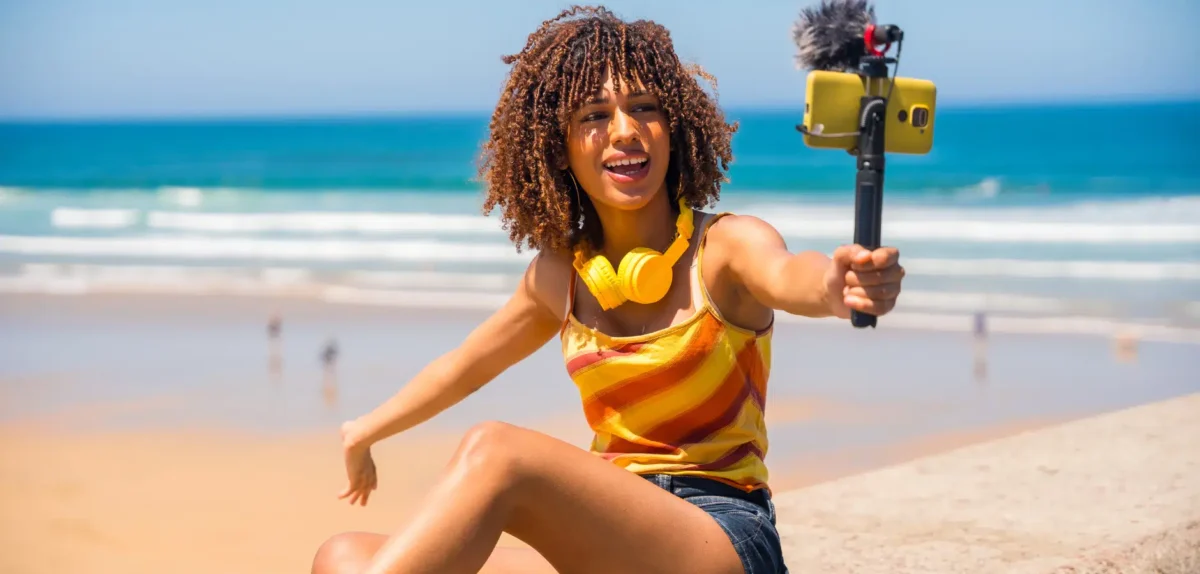Affiliate marketing has evolved from static promotions to dynamic, engaging content with content creators in the mix.
These trusted creators are now building deeper connections and changing the industry.
Last year, affiliate creators generated $1.1 billion through affiliate marketing, a 93 percent increase from 2021. That’s nearly double in just three years and clear evidence that creator-led affiliate programs are scaling fast.
As audiences grow more selective about who they listen to, you’re no longer competing for attention with discounts and banner ads. You’re competing with trusted voices, personal stories, and everyday content that builds real relationships.
That’s where creator-led affiliate programs come in. Instead of pushing links, creators build trust. Instead of chasing traffic, they create value. When you partner with creators the right way, you gain access to communities that are genuinely invested. The kind that engages, trusts, and buys.
This blog will discuss:
- How the affiliate marketing model has evolved
- Tips to adapt your strategy for working effectively with creators
- How to build and scale your strategy to see maximum results
The evolution of creator affiliate marketing: From transactional to relatable
Creator affiliate marketing didn’t emerge overnight.
In the early 2000s, affiliate strategies were driven by static blog posts, discount codes, and SEO-stacked websites built for clicks. Affiliates prioritized volume over connection, and most content felt transactional—designed to drive traffic, not trust.
Social media changed that. As YouTube, Instagram, and TikTok grew, content creators began building audiences around shared interests, lifestyles, and expertise. Their recommendations felt more like personal advice than promotion, and audiences responded.
This was the beginning of a new model, one where digital content creators guided buying decisions through connection, not conversion hacks.
Today, creator affiliate marketing sits at the center of that shift. It’s defined by content niches, shared values, and long-term partnerships between brands and creators.
Here’s how that transformation took shape.
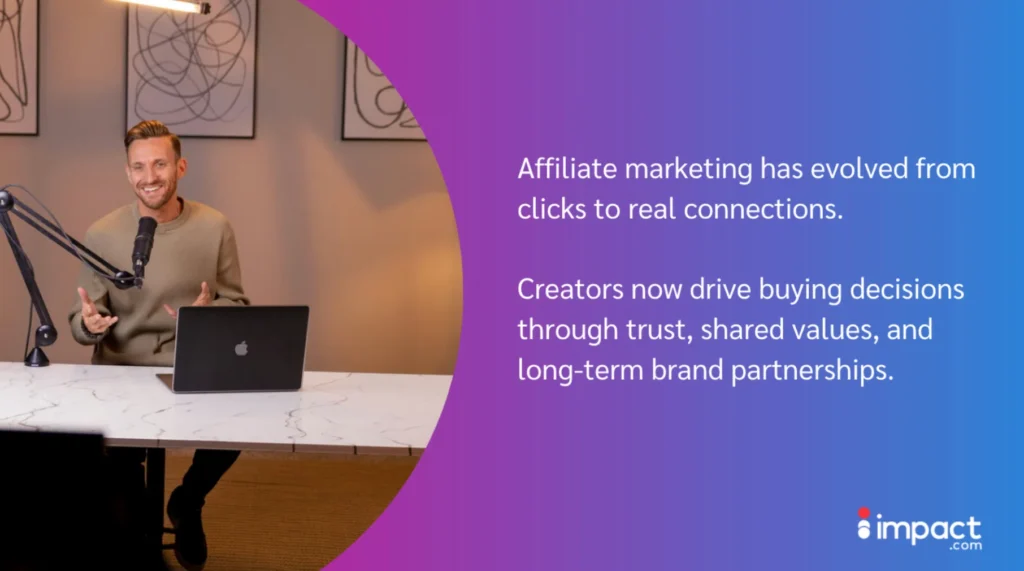
Timeline: Key milestones in the evolution of creator affiliate marketing
- 2008–2012: Blog-first strategies dominate: Affiliates focus on volume through SEO and discount codes. The experience is transactional. Trust is optional.
2013–2016: Social media expands affiliate reach: Platforms like YouTube and Instagram allowed content creators to blend lifestyle content with links, setting the stage for content creator partnerships. - 2017–2019: Monetization tools gain traction: Amazon Associates and LikeToKnowIt make it easier for digital content creators to earn from their influence without relying on sponsorships alone.
- 2020–2022: Short-form video reshapes the funnel: TikTok changes the game. Affiliate products are wrapped into video content that entertains, informs, and sometimes goes viral.
- 2023–2025: Creator commerce becomes mainstream: Native shopping tools fuel creator commerce models as brands shift toward creator-led partnership programs rooted in trust, niche alignment, and co-created value.
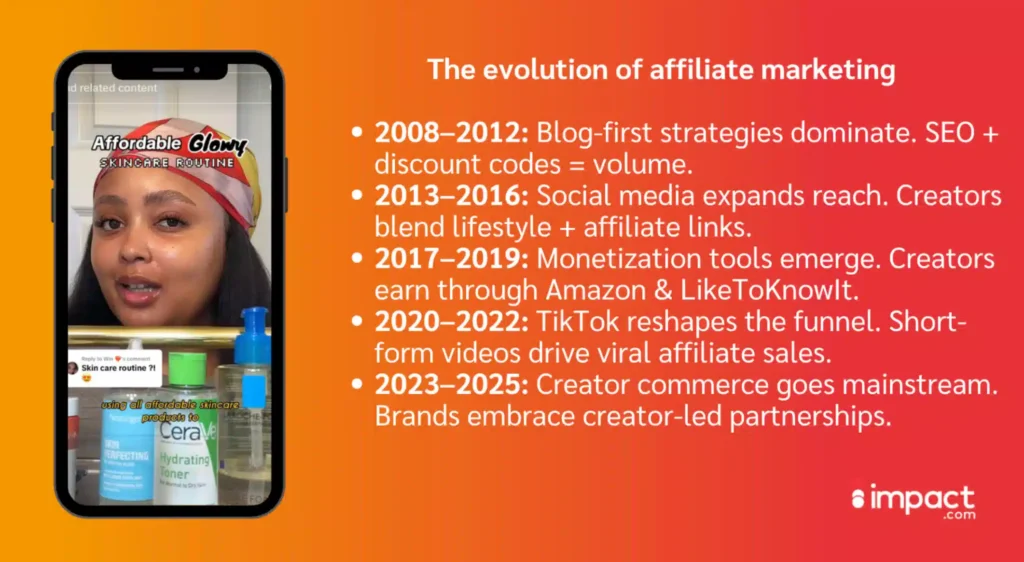
The affiliate marketing evolution: From SEO blogs to creator-driven commerce fueled by trust and niche value.
Why brands must rethink their affiliate strategy
Here’s the opportunity: affiliate programs have so much room to grow.
Many older programs focus on tracking clicks, but today’s creators and audiences expect more. The way we connect has evolved, and affiliate programs can too.
Today’s content creators are reshaping the game:
- They’re not just posting links—they’re running thriving businesses.
- They’re building engaged, loyal communities.
- They’re creating high-quality content that resonates far beyond a single post.
Creators aren’t just contractors—they’re true collaborators.
When brands treat creators as partners, the results are undeniable.
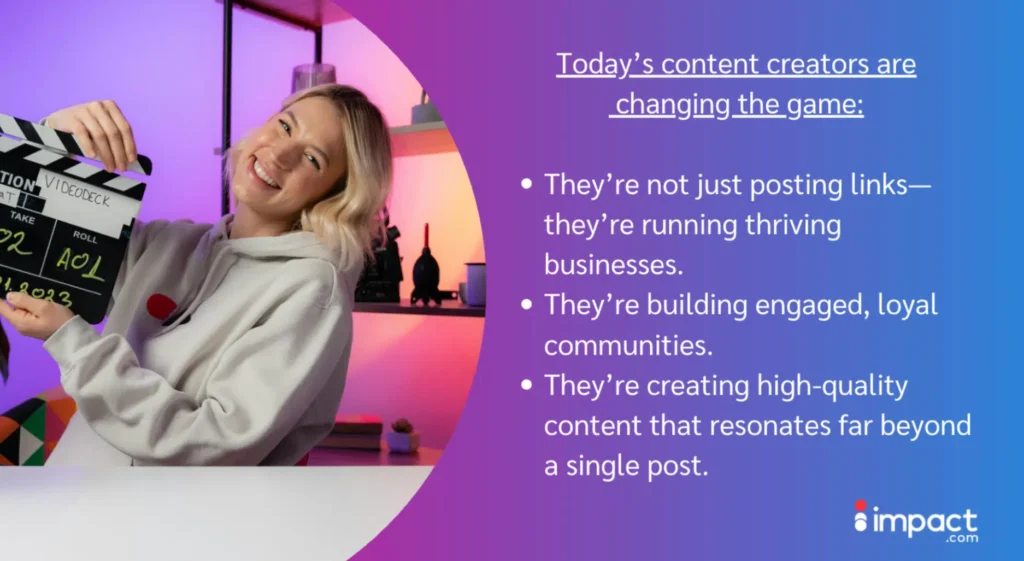
Build the right systems is a must when recruiting partners
A study by impact.com and Adweek shows exciting opportunities for brands to build better systems for partner recruitment.
Here’s what creators have to say:
- 86 percent want to grow brand collaborations—a huge opportunity for brands to connect
- 84 percent are overwhelmed when managing offers—highlighting the need for more thoughtful, personalized outreach.
Creators also want quality partnerships over quantity, something brands should keep in mind:
- ✅ 80 percent prioritize clear compensation.
- ✅ 39 percent value creative freedom for lasting partnerships.
Gone are the days of simple spreadsheets and hoping for conversions. Success now comes from:
- ➡️ Aligning with the right audience.
- ➡️ Offering meaningful content support.
- ➡️ Providing long-term incentives for mutual growth.
Brands adopting these strategies are already seeing incredible results.
How PUMA transformed its affiliate program with impact.com
Program overview
PUMA’s Southeast Asia affiliate program used to rely heavily on just one cashback partner, generating nearly 80 percent of its sales from them. The system was fragile, manual, and prone to fraud. But everything changed when they switched things up with impact.com.
The team’s approach
By expanding their partnerships and collaborating with content creators, they brought the products to life through:
- Gear reviews
- Demo videos
- Motivational fitness stories
These weren’t just random pieces of content. They were crafted by creators who understood the audience, building trust and sparking curiosity that led to real conversions.
The results
- Fraud dropped over 90 percent
- Active partners doubled
- Affiliate-driven sales increased 2.5x across Singapore, Malaysia, and the Philippines
- Cost per action (CPA) reduced by up to 30 percent
Here’s how to include effective creator monetization strategies:
- Match the message to the creator’s voice.
- Use the right content format.
- Let creators take the lead.
Affiliate programs built around creators don’t just drive sales—they build loyalty, expand reach, and create lasting connections with new communities.
Want to know the secret of top-performing brands? They work hand-in-hand with creators from day one.
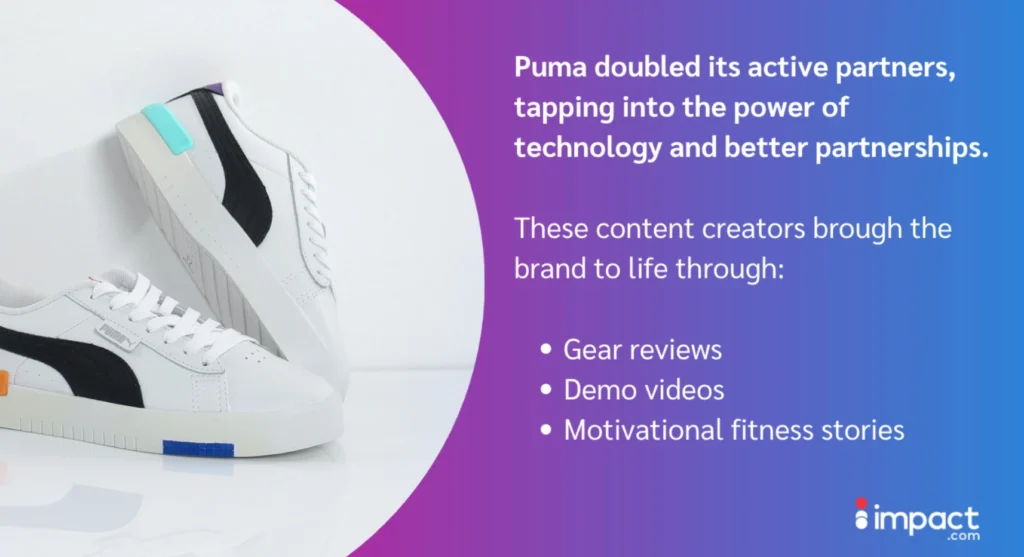
How social media platforms fueled the creator economy
Affiliate marketing didn’t evolve alone—it grew alongside the platforms.
As tools advanced and audiences shifted, the doors opened for anyone with a phone and an opinion to build a following.
The result? The booming creator economy. In this thriving space, affiliate marketers monetize their skills, content, and influence online.
Social platforms changed the game, putting power directly into the hands of creators. Profiles became stages, toolkits, and storefronts, giving creators endless opportunities to connect, create, and thrive.
Platforms lowered the barrier to entry
Apps like TikTok, YouTube, Instagram, and Pinterest turned phones into production studios.
Anyone could become a content creator, whether they specialized in cooking, gaming, home décor, or quiet luxury hauls. The only real requirement? Having something to say.
That accessibility changed everything. Creators from diverse backgrounds began building niche audiences with nothing but a smartphone and a point of view.
No agents. No publishers. Just video content, personality, and consistency.
Once platforms began adding monetization features like YouTube Partner Program, TikTok Creator Fund, and Instagram affiliate tools, the jump to creator monetization strategies became almost automatic.
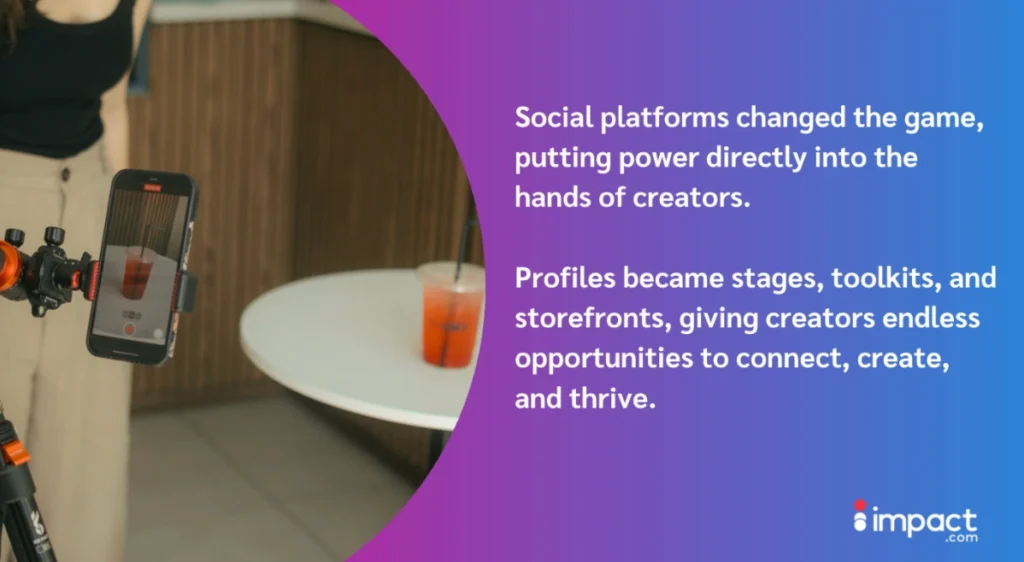
Creator commerce and social commerce redefined the funnel
Two key terms to know:
- Creator commerce: When content creators sell or recommend products using their brand, audience, and platform tools.
- Social commerce: When the entire shopping journey—from discovery to checkout—happens directly on a social media platform.
Kristina Nolan also adds that social commerce is evolving with platforms like TikTok Shop and YouTube Shopping turning influencers into major sales drivers. Integrated cart checkout is making it easier for brands to convert real-time engagement into sales.
No extra tabs. No extra steps. People can buy right where they scroll.
That seamless flow is why creator commerce models are thriving. A fitness creator can post a short-form video of their morning routine, link their supplements or yoga mat, and generate passive income, all without leaving the app.
Brands are tapping into this model by working with creators who align with their target audience, voice, and values. The creator provides access, context, and trust. The platform provides the path to purchase. Simply sharing affiliate links are a thing of the past.
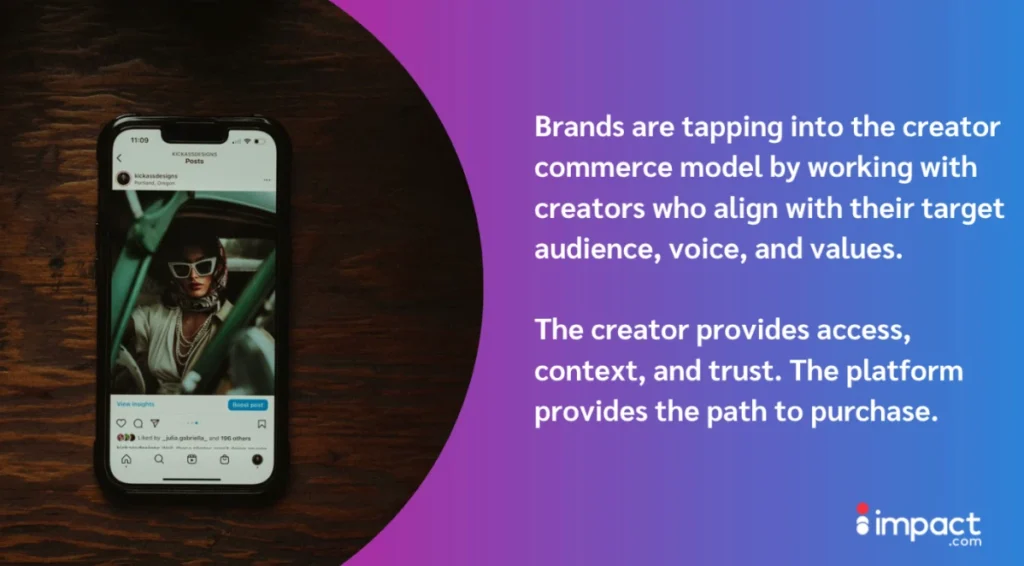
Creators build communities, not only reach
Community over reach—that’s where creator partnerships shine the most.
Creators don’t just post; they engage. They reply to comments, share stories, and build loyalty with their audience.
This makes them incredibly effective at driving authentic engagement, far beyond what traditional affiliate marketing can achieve. When a creator recommends a product, it feels like advice, not a brand campaign.
More brands are now viewing creators as long-term partners, not just promoters. Sponsored posts, affiliate deals, and exclusive codes are part of deeper relationships built on trust, alignment, and shared goals.
Here’s what creators value most in these partnerships:
- 53 percent prioritize product quality in long-term collaborations.
- 40 percent value lucrative compensation.
The takeaway? Quick, one-off outreach won’t cut it. Build strong partnerships with clear communication, collaboration, and respect.
The opportunity and the friction
With this shift, comes a massive opportunity for brands. Here’s the current landscape at a glance:
The opportunity
- Creator affiliate marketing unlocks high-trust, high-engagement channels.
- Skip the high costs of traditional media.
- The potential is huge, but the rules are still evolving.
The challenges
- Unpredictable algorithms impact creators.
- Monetization features differ across platforms.
- Partnerships often fail without clear expectations.
The solution
Partnership platforms like impact.com bridge the gap through:
- Easy discovery and tracking.
- Streamlined communication.
- Fair compensation for creators.
Brand considerations
- Affiliate marketing’s evolution is powered by people.
- Creators bring influence; platforms help turn it into income.
- For brands, it’s all about trust, alignment, and long-term value.
The rise of creator-driven affiliate content
Traditional affiliates relied on SEO-heavy tactics and discount-driven funnels. The goal was simple: drive clicks and conversions, fast.
Today’s creators take a new approach—one that helps, educates, and builds trust.
Their content goes beyond promos, showing how products fit into real life. Here’s how:
- Tutorials: Step-by-step guides on how a product works.
- Reviews: Honest takes covering pros, cons, and personal experiences.
- Comparisons: Side-by-side breakdowns to help viewers choose.
- Day-in-the-life vlogs: Showcasing products as part of everyday routines.
- Behind-the-scenes clips: Offering context, not ads.
This is content that connects, not just sells.
That shift from sales pitch to problem-solving has real upside. Video-based affiliate content drives 49 percent higher conversion rates, and campaigns featuring user-generated content outperform traditional ads by 28 percent.
These formats work because they feel personal, not promotional. They come across more like advice from a friend than a brand message.
Resident builds a steady stream of content partners
Brands like Resident are moving beyond simple influencer shoutouts to build deeper, more effective creator partnerships. Here’s how they nailed it:
Tackling buyer concerns for high-consideration purchases
To promote their mattresses—an infrequent, high-consideration purchase—Resident partnered with creators to answer key buyer questions:
- Is it comfortable?
- Will it ship on time?
- What happens if I don’t like it?
These videos made the buying process feel transparent and less risky by addressing common concerns around comfort, delivery, and returns.
Results: Creator-led content outperforms traditional ads
By combining influencer content with paid media, Resident saw game-changing results:
- Traditional ads: ROAS of 0.89 (resulting in losses).
- Creator-led Content: ROAS of 1.08—achieved with just the cost of a gifted mattress.
Key takeaway
Resident’s success shows that deeper creator partnerships—focused on building trust and addressing buyer questions—can drive real impact and outperform traditional advertising.
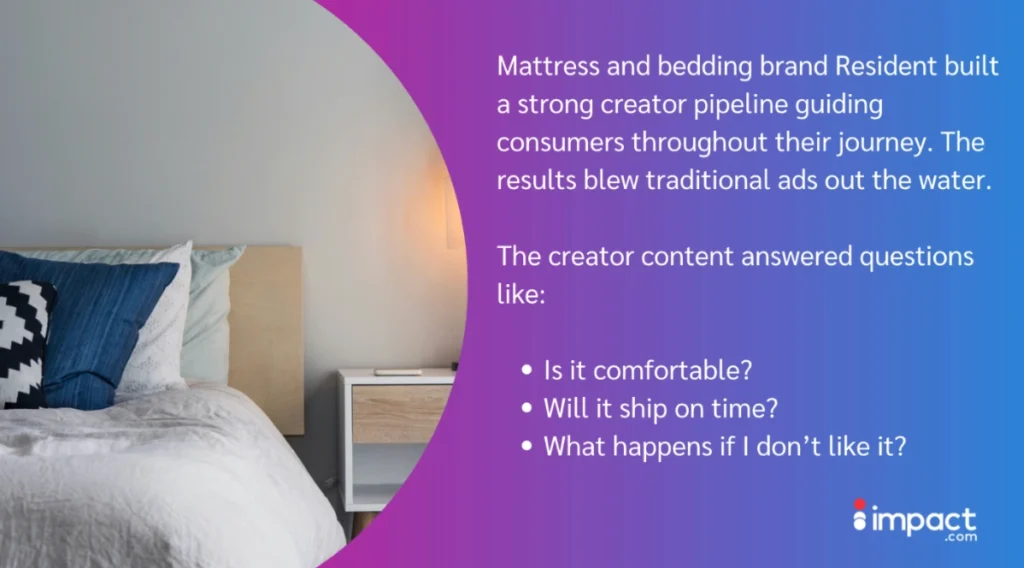
Creators build long-term trust
Where traditional affiliates chase short-term clicks, creators build long-term trust.
They connect with niche audiences, drive consistent engagement, and guide real purchase decisions. Influencer-driven campaigns boost sales by 46 percent, and 88 percent of consumers say creator recommendations influence what they buy.
This is why 31 percent of creators now rely on affiliate income as a core revenue stream.
It isn’t simply performance marketing. It’s a partnership model, and creators expect to be treated that way.
Why brands are shifting to creator partnerships
This shift centers less on format, more on how creators influence buying behavior. It reflects a deeper change in how content strategy and affiliate marketing intersect.
Creator-driven affiliate campaigns combine the precision of paid media with the trust that digital content creators bring to their audiences. And the benefits for brands are clear:
- Higher engagement and conversions: Messages from trusted content creators resonate more with their target audience, leading to stronger brand engagement, better click-through rates, and improved conversions.
- Cost-saving strategies: Brands pay only when results are delivered, keeping customer acquisition costs low and improving campaign ROI.
- Built-in targeting: Creators’ social media accounts attract niche audiences, giving brands direct access to highly relevant segments across industries like home goods, skincare, and SaaS.
- Long-term content value: Strong video content, short-form videos, and blog posts continue converting for months, helping campaigns scale without inflating ad spend.
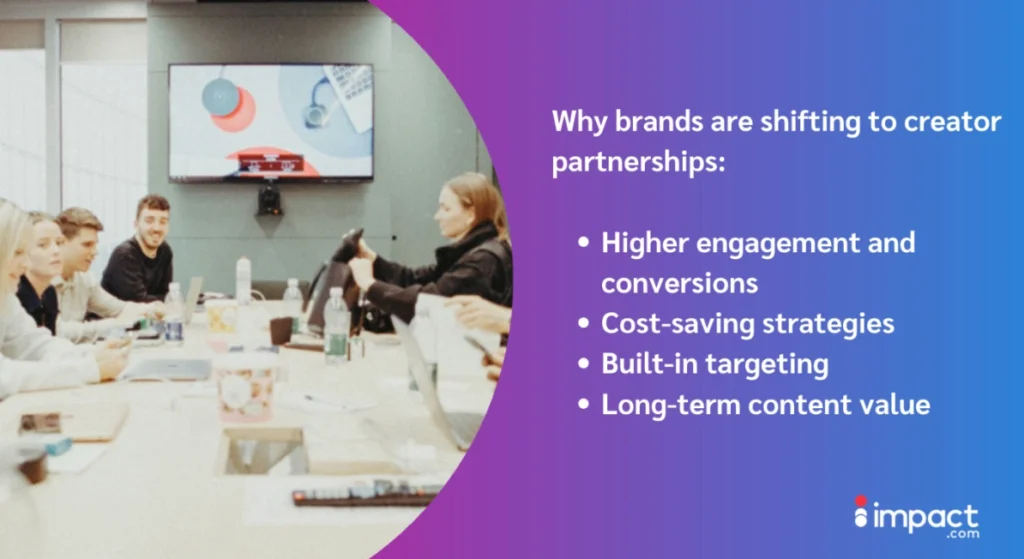
Layered content strategies drive results
Effective creator-led partnership programs use tiered strategies that follow the buyer’s journey.
At the top of the funnel, short-form videos like Reels or TikToks generate attention. Mid-funnel content, like tutorials and walkthroughs, builds trust. At the bottom, in-depth reviews and limited-time offers drive conversions.
This mirrors a traditional sales funnel, adapted for social media platforms and how people shop today.
The most effective results come when digital content creators have the creative freedom to adapt the content to each stage, rather than sticking to a rigid brief.
Content creator Tina Angelina adds that an unfiltered style of communication comes off as more authentic, something audiences value more than polished content.
Custom codes and exclusive deals build momentum
Custom codes like “JASMINE15” serve a clear purpose. They help creators track conversions and give their audiences a sense of exclusivity. Brands see measurable impact—not just views or likes.
According to eMarketer, exclusive deal codes influence 28 percent of consumers actively motivated by special offers.
This model of creator commerce thrives on authenticity. When a social media post includes a real recommendation with a relevant discount, it feels more like a tip from a friend than a sales pitch.
That’s what makes value-added affiliate content work. It’s aligned with the current trends driving the creator economy. It’s trust over hard selling, relevance over reach, and content niches over mass marketing.
Short-form video: The creator’s most powerful affiliate tool
Short-form videos have become essential to creator affiliate marketing, driving engagement, reach, and measurable brand outcomes. Across every major social media platform, they now outperform other types of content by a wide margin, and not by accident.
Video content enhances brand engagement
Branded videos trigger emotional connection and are easier to remember than static posts.
Studies show that viewers retain 95 percent of a message when they watch it in a video, compared to 10 percent when reading it in text.
That makes video the most powerful medium for boosting awareness and trust.
Short-form videos give brands a competitive edge
- Short-form content reaches the top of the page: Instagram Reels, YouTube Shorts, and TikTok prioritize it in their algorithms.
- Aligns with consumer trends: People want quick, emotional, and engaging content.
- It’s cost-effective: Easy to produce yet drives high conversion and boosts brand awareness, especially with creator commerce models.
- Worldwide appeal: 63 percent of global social media users prefer short content.
Best practices tailored for brand success
To make short-form videos effective in creator-led partnership programs, you need to focus on story, clarity, and utility:
- Story-first structure: Let creators showcase genuine value-added affiliate content. Product demos and personal moments aligned with brand messaging.
- Mobile-first optimization: With over 75 percent of video views occurring on phones, vertical formats and readable overlays are essential.
- Clear calls to action: Include simple prompts like “Swipe up,” “Link in bio,” or “Use code”, to signal the next move.
- Repurpose top clips: Transform high-performing segments into longer ads, email content, or blog posts to maximize ROI.
Short-form content becomes a hybrid of awareness and conversion when designed this way, especially with creative freedom fueling authenticity.
Boosting brand partnership efforts with video content
In modern creator-led partnership programs, short-form video acts as both discovery and conversion tool.
It’s a natural fit for the affiliate model evolution, where the emphasis is shifting from traffic to trust.
Co-branded short-form videos allow digital content creators and brands to share audiences efficiently while reinforcing aligned messages.
This deepens engagement and drives higher returns, especially when content is customized to reflect the content niche and preferences of each target audience.
Measuring success for data-driven branding decisions
Relationship-based affiliate marketing relies on performance. That means tracking:
- Engagement rate
- View-through and click-through rates
- Conversions and affiliate revenue
To refine creator monetization strategies, you should also run A/B tests and segment performance by audience demographics. These insights inform future content strategy, helping you improve each campaign while maintaining strong results over time..
How impact.com supports creator-led affiliate models
impact.com was built to power the affiliate model evolution, not just track clicks.
The platform is purpose-built to support content creator partnerships, helping brands and digital content creators work together more efficiently and transparently across the entire life cycle of a campaign.
Solving key pain points with technology
impact.com addresses the most common friction points in creator affiliate marketing with smart, scalable tools:
Transparent payments
Automatic, real-time payment processing removes uncertainty.
Digital content creators know exactly when and how they’ll be paid. No more chasing invoices.
Smarter discovery
You can discover and vet successful content creators based on platform, content niche, audience demographics, and campaign goals.
AI-powered matching shortens the time to launch.
Simplified communication
Built-in messaging and task management keep content strategy and feedback loops organized and clear.
Actionable analytics
Detailed reporting tools track engagement, affiliate marketing performance, and conversion.
This makes it easier to double down on what’s working and improve what’s not.
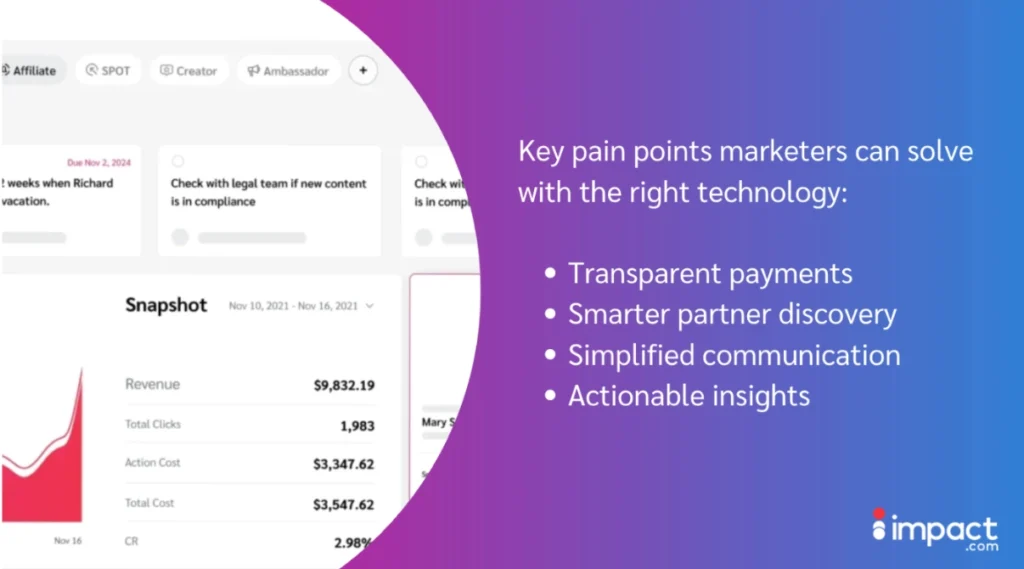
Tools that benefit both creators and brands
impact.com’s tools are designed for relationship-based affiliate marketing that benefits both sides of the partnership.
For creators:
- Branded dashboards showing performance and earnings in real time
- Transparent, consistent payment timelines
- Custom promo codes and affiliate links that track results without complexity
- Streamlined workflows with all your tasks in one login
For brands:
- AI-powered creator discovery that filters by niche, platform, and engagement rate
- Bulk onboarding and campaign invites for efficient scale
- Unified campaign dashboards that track social media posts, approvals, and deadlines
- Tools that reduce customer acquisition costs and increase campaign ROI
Brand protection and creator alignment at scale
As creator-led partnership programs scale, so do the risks: But impact.com offers solutions to protect both your brand and your investment:
- Social Listening tools track mentions across social networks, surfacing both organic buzz and risks
- Social Monitoring ensures partners meet disclosure requirements and brand safety standards
- Automated alerts help flag unapproved terms or off-brand messaging
- Swift resolution workflows allow you to quickly request edits or feedback from creators
These tools help guarantee your affiliate marketing campaigns stay on message and on brand, even across dozens or hundreds of social media accounts.
Streamlined task management and creative collaboration
impact.com’s Creator features are built around the realities of managing many creator relationships. Key features include:
- Creator Defines: Let creators propose tasks based on their unique skills and creative strengths.This empowers better collaboration and more authentic value-added affiliate content
- Flexible timelines: Adjust deadlines for late-joining partners without disrupting your workflow
- Work email integration: Increases response rates by sending messages from your official domain
- Task logs and feedback tools: Provide visibility into every step, including rejected drafts and final approvals
This structure keeps your content creator partnerships aligned without stifling creative freedom—a balance that drives better results.
Data-driven insights for smarter campaigns
impact.com simplifies how you measure success across every social media platform. You can:
- Track clicks, views, conversions, and revenue, all linked to the right content creator
- Compare performance across audience segments and content types like short-form videos, blog posts, and product demos
- Use Wrap Reports to generate presentation-ready campaign summaries in seconds
- Include manual metrics and approvals when needed, maintaining flexibility and transparency
These insights help brands refine their content strategy, choose the right partners, and iterate quickly based on what resonates with each target audience.
impact.com + OLIPOP = a thriving, colorful campaign
The colorful, prebiotic soda brand OLIPOP partnered with impact.com and GravityFed to revolutionize its creator marketing strategy, combining technology with a well-executed creator pipeline. Here’s how they did it:
Leveraging impact.com to build a thriving creator pipeline
- Simplified affiliate program management for OLIPOP.
- Enabled seamless creator onboarding with automation tools.
- Provided powerful performance tracking to measure success.
Key highlights
Always-on creator campaigns:
OLIPOP turned gifting into an ongoing creator program filled with fun, authentic content.
1.9k creators engaged
Their program scaled to nearly 1,9k creators, delivering massive reach and engagement.
Record-breaking return on investment (ROAS):
Consistently delivering high ROAS, the program broke new ground with a recorded 1,200 percent one year.
By combining creative strategy with smart technology, OLIPOP empowered creators to authentically share its story—and the results speak for themselves.
Practical frameworks to implement creator-led affiliate strategies
Building a successful creator affiliate program isn’t just about following steps. It’s about establishing interconnected strategic pillars. This framework offers three core phases for brands to launch or scale creator-led affiliate programs.
Phase 1: Lay the foundation for solid partnerships
This initial phase focuses on laying the groundwork for a robust and effective creator-affiliate program. It’s about strategic planning, identifying the right collaborators, and designing an appealing incentive structure.
Set clear goals
Start by defining specific KPIs that align with your overall marketing and business objectives. These could include:
- Click-through rates (CTR)
- Revenue per creator
- Conversion rates
- Customer lifetime value (CLTV)
Always connect every campaign back to these goals to measure your ROI and maintain strategic focus.
Pro brand tip: Use a real-time dashboard to track KPIs. This makes it easier to spot trends and adjust your strategy quickly.
Recruit the right creators
When recruiting partners, prioritize audience alignment, content style, and platform fit. Focus on creators with high engagement rates over just follower count.
As Jeff Melton at impact.com notes, engagement is what drives purchases, not just large followings. Many brands are shifting from macro-influencers to micro-creators who often have more dedicated audiences.
Build a prospect list using:
- Creator marketplaces
- Influencer networks
- Manual outreach
Don’t forget to explore niche or adjacent communities to discover untapped audiences.
Pro brand tip: Look for creators who already genuinely love your brand. Their authentic enthusiasm will translate into more compelling content.
Create rewards-driven commission models
Creators are motivated by strong incentives. Consider offering:
- Tiered commissions: Higher rates for better performance.
- Recurring commissions: Not just a once-off commission for referrals.
- Flat-rate fees: A set payment for specific deliverables.
- Performance-based bonuses: Extra rewards for exceeding targets.
Assign personalized promo codes and tracking links to ensure accurate attribution for every sale or lead. Always be transparent about the earning structure from the start to build trust and a strong working relationship.
Pro brand tip: Experiment with different incentive structures to see what motivates your creators most—a one-size-fits-all approach rarely works.
Phase 2: Foster strong collaboration and content creation
This phase focuses on empowering creators to produce authentic content that resonates. It also emphasizes building strong, collaborative relationships. These efforts aim to drive consistent performance.
Provide tools and support
Creators thrive with consistent support. Share essential resources like:
- Detailed product information
- Frequently asked questions (FAQs)
- Branded visuals and messaging guidelines
Provide these guidelines, but always allow creators to maintain their unique, authentic voice. Offer thorough onboarding support and be responsive to their questions and feedback.
Pro brand tip: Create a centralized resource hub where creators can easily access everything they need, from visuals to campaign updates, at any time.
Encourage authentic content
Let creators showcase your product in their own unique way through:
- Unboxing videos: A popular way to introduce products.
- Product walkthroughs: Demonstrating features and benefits.
- Storytelling formats: Weaving your product into relatable narratives.
Always prioritize real experiences and honest feedback over overly polished or scripted posts. As Marie Montano at impact.com states, the rise of AI-generated content will increase the demand for authenticity. Audiences will gravitate towards “real-day” content instead of aspirational highlight reels.
Pro brand tip: Encourage creators to share behind-the-scenes moments or even bloopers. Audiences connect more deeply with relatable, unscripted content.
Maintain strong relationships
Show your appreciation with perks like:
- Early product access
- Personalized gifts
- Exclusive behind-the-scenes experiences
Recognize your top performers, whether publicly or privately, to boost their loyalty and motivation. Keep communication channels open—regularly share updates, feedback, and new opportunities.
Pro brand tip: Host exclusive creator events or virtual meetups to build a strong sense of community and deepen your relationships.
Phase 3: Optimize and scale your creator-affiliate program
The final phase focuses on continuous improvement, leveraging data to refine strategies, and identifying opportunities to expand the program’s reach and impact.
Track performance and optimize
Once your program is active, continuously monitor its progress. Keep a close eye on key metrics such as:
- Clicks
- Conversions
- View-through rates
- Affiliate revenue
Segment your data by audience demographics, content type, and platform to gain deeper insights. Double down on what’s working with high-performing creators and content, and make small, strategic adjustments in underperforming areas.
Pro brand tip: Use trending maps or analytics tools to identify where audiences might be dropping off and refine your strategy accordingly.
Scale your strategy
Once your program is stable and performing well, it’s time to identify areas for growth and improvement:
- Expand into new verticals or regions to broaden your reach.
- Use A/B testing and audience insights to refine your content strategy.
- Adjust commission rates or bonuses as your program matures to remain competitive.
Pro brand tip: Consider partnering with micro-creators in new markets; they often have highly engaged audiences and can be more cost-effective.
Measure program performance
Numbers matter. Here’s how to measure your success and inform future campaigns:
- Compare results to your original KPIs to evaluate overall performance.
- Use these insights to improve your next campaign—understand what worked and what didn’t.
- Fine-tune your targeting, messaging, and incentives over time to build an even stronger program.
Pro brand tip: Share success stories with your creators. This will inspire them and showcase the potential within your program.
FAQs
Content that feels authentic to the creator’s audience tends to perform best. Reviews, tutorials, unboxings, and personal stories are particularly effective, as they showcase genuine experiences with a product. Short-form videos on TikTok or Instagram are highly engaging, provided the content aligns with the creator’s usual style and resonates with viewers. Creators who integrate affiliate products naturally into their content often see better results than those who take a purely sales-driven approach. The key is to build trust with the audience by being transparent and relatable.
Successful creators start by deeply understanding their audience’s preferences and habits. They post consistently, ensuring their followers know when to expect content. Performance tracking through analytics helps them refine their approach, identifying what works and what doesn’t. They experiment with fresh ideas, whether it’s exploring new collaborations, adopting new content formats, or leveraging trends. A combination of engaging content, smart platform choices, and adaptability is what keeps their strategy effective.
Influencer marketing focuses on building brand awareness, often through sponsored posts or partnerships. It typically involves creators being paid upfront to showcase a product or service to their audience. Affiliate marketing, on the other hand, is results-driven and commission-based, rewarding creators for the sales, sign-ups, or leads they generate. While influencer marketing casts a wide net, affiliate marketing prioritizes measurable outcomes and performance. Both strategies can overlap, but the goals and payment models set them apart.
Video content allows creators to demonstrate products in action, building trust and credibility with their audience. Platforms like TikTok, YouTube, and Instagram make it easy to share videos that showcase features, benefits, and personal experiences. Videos also encourage higher engagement rates, as viewers can see the product’s value more clearly than in static images or text. Affiliate links or discount codes embedded in the video or description make it simple for audiences to take immediate action. Ultimately, video combines entertainment with persuasion, making it a powerful tool for driving conversions.
Creator commerce refers to all the ways creators monetize their content and influence, spanning merch sales, product collaborations, ad revenue, subscriptions, and more. Affiliate marketing is one part of this ecosystem, focusing specifically on earning commissions through product referrals. Unlike other streams, affiliate marketing ties earnings directly to performance, rewarding creators for generating sales or leads. It’s often seen as a win-win, benefiting creators, brands, and consumers alike. As creator commerce evolves, affiliate marketing remains one of the most accessible and scalable income streams for creators of all sizes.
From clicks to connection: Creator-affiliate models are the way forward
Affiliate marketing isn’t outdated, it has evolved from static promotions to real connections.
Creators are leading the way, turning traditional affiliate programs into partnerships built on trust, authenticity, and real value.
These creators do more than drive traffic. They resonate with audiences, create meaningful content, and influence decisions in ways old-school affiliates never could.
When brands provide the right support, the results are undeniable:
- Broader reach
- Campaigns that resonate
- Long-term partnerships
- Better ROI
If your affiliate program feels stuck in the past, now is the time to rethink your approach.
impact.com gives you the tools to build creator-driven strategies that deliver results. Schedule a demo today.
Discover more compelling content here:
- How to pay content creators in 2025: 7 proven payment methods that drive results [blog]
- Driving affiliate success through talent, strategy, and stronger partnerships [podcast]
- Building a profitable creator community: How OLIPOP’s hybrid commission approach drives 12% of sales [playbook]
- 4 must-have email templates for effective partner recruitment [worksheet]
- Search and partnerships: How to find and recruit partners for your affiliate and influencer programs [ebook]
- Affiliate Marketing Success Path for SMBs [free course]









